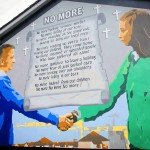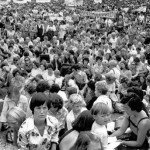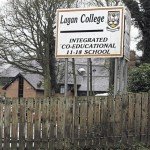
Attempts to end sectarianism and violence in Northern Ireland date back to the first weeks of the Troubles. Many groups and individuals worked to negotiate truces or ceasefires, broker peace deals or moderate radical views. While some peace activists enjoyed short-lived or locally based successes, ending paramilitary violence and securing peace in Northern Ireland was an almost impossible proposition. Most peace movements found the political divisions too wide and sectarian hatred too intense. As the Troubles progressed, these divisions were compounded and intensified by the cycle of violence. Any step towards peace would require political recognition of the enemy, followed by negotiation and compromise – not to mention a degree of mutual forgiveness. With every death, these objectives became harder to achieve. This page discusses some prominent Northern Ireland peace movements, how they formed and the strategies they used to bring peace to the Six Counties.
The Peace People
One of Northern Ireland’s best-known peace movements was the Community of Peace People. This movement was started by Betty Williams and Mairead Corrigan in 1976. Their involvement was triggered by an incident in Finaghy Road, Belfast when a Provisional IRA driver was shot dead by British soldiers while making a getaway. His out of control car ran over Corrigan’s sister, Anne Maguire, and her three children. Maguire survived but all three children – eight-year-old Joanne, two-year-old John and six-week-old Andrew – were killed. Mairead Corrigan appeared on television shortly after and made a tearful plea for peace. The incident was witnessed by an Andersonstown woman, Betty Williams. Appalled by the senseless deaths of the children, Williams organised a petition and a protest march, attended by women pushing baby carriages.

Corrigan and Williams met and joined forces. Within a few days of the children’s deaths, they formed a movement called Women for Peace. Concerned it might be interpreted as a feminist movement, Williams and Corrigan retitled it the Community of Peace People. They were also joined by Ciaran McKeown, a Dublin journalist. The three planned more marches across Northern Ireland, the Republic of Ireland and Great Britain, aiming for one each week between August and December 1976. The group also obtained the backing of the unions. Williams and Corrigan kept the Peace People apolitical, refusing to meet politicians, avoiding political statements and banning political colours or emblems from marches. In August 1976 they drafted a ‘Declaration of Peace’ that was read aloud before every march.

Peace People marches grew rapidly and attracted considerable media coverage. The second march, through Protestant areas of Belfast, attracted around 50,000 participants. The third march followed a provocative route, crossing from Falls Road into the Protestant stronghold of Shankill. In the autumn of 1976 Peace People marches were held in dozens of locations, including Derry, Antrim, Enniskillen and Omagh; in Drogheda, site of the Battle of the Boyne; and in several English cities. These marches drew tens of thousands of people but were not without their critics. Conspiracy theorists claimed Williams and Corrigan were political stooges funded by the IRA or Sinn Fein. Several marches were disrupted by violence and many participants (including Williams and Corrigan themselves) were assaulted or pelted with rocks. Despite these setbacks, the Peace People attracted global recognition. In 1977 Williams and Corrigan were awarded the Nobel Peace Prize, becoming the youngest recipients of the award at that time. The Peace People collapsed in 1980 following internal disagreements about money and leadership.
The Ulster Project

Another significant peace initiative was the Ulster Project, an exchange program for Northern Ireland teenagers. The Ulster Project was formed in 1975 by Reverend Kerry Waterstone, a Church of Ireland (Protestant) priest. Waterstone had spent the previous year on pastoral exchange in the American state of Connecticut. While there he observed interaction and discussion between American teenagers of different racial, religious and cultural background. If American teens could resolve their differences and live alongside each other, Waterstone figured, so could Northern Irelanders. Together with American reverend Steve Jacobson, Waterstone developed a program that sends Catholic and Protestant teenagers on a four-week exchange to cities in the United States. Isolated from the poisonous sectarianism at home, these teens learn to work and live together; they also experience life in a tolerant, non-sectarian society free of violence. More than 10,000 teenagers have participated in the program since its inception. One volunteer has described the work of the Ulster Project as “sowing the seeds of peace”.
Education and housing reforms

Peace initiatives targeting young people have been tried in Northern Ireland. Peace campaigners have long pointed to segregation in education as an important contributor to sectarianism. In 1970 more than 95 percent of children in Northern Ireland attended a single-faith school. Students attending segregated schools seldom interacted with children outside their own religion; their views and attitudes of other religions were shaped by adult teachings and prejudices, rather than their own experiences. In 1974 a lobby group called All Children Together (ACT) was formed to campaign against segregated schools. In 1981 a group of Belfast parents, acting with the support of ACT, started their own integrated school. Lagan College began in South Belfast with just 28 students. Today it is one of Belfast’s most popular schools, with more than 1,230 students of diverse religious backgrounds. Northern Ireland now boasts more 50 integrated primary and secondary schools, though the majority of its students still attend segregated schools.
“Many peace activists in Britain and Ireland have avoided trying to tackle the conflict. Those who felt obliged to act have adopted very different strategies, depending on their political analysis of the situation and beliefs about peace. Some radical pacifists have seen British rule in Northern Ireland… as the primary obstacle to a just and peaceful resolution of the conflict. Others have concentrated on local work in the community, designed both to meet some of the problems of poverty and deprivation and to bring Catholics and Protestants together.”
April Carter, historian
Housing was another focal point for peace activists. Before the Troubles, public housing allocations were managed by local councils, which were notorious for favouring Protestants or Unionists. In 1971 the Stormont government created the Northern Ireland Housing Executive (NIHE), a body tasked with distributing housing fairly and impartially. While the NIHE alleviated discrimination in housing allocations, it made no attempt to integrate Protestants and Catholics. During the NIHE’s first 20 years housing segregation actually increased. By the late 1990s around 92 percent of Northern Ireland’s public homes were segregated by religion. Peace campaigners lobbied against this, urging initiatives for mixed housing. Local groups like the Ballynafeigh Community Development Association (BCDA), formed in 1974 at the height of the Troubles, worked to forge links between Catholics and Protestants in suburban Belfast. The government did not attempt to integrate housing until the NIHE’s Shared Future initiative in 2006.
Bridging the sectarian divide
Some peace activists have pursued a simpler objective: to get people talking. The Derry-based Peace and Reconciliation Group (PRG) is one such organisation. Started by former Peace People members in 1976, the PRG seeks to bridge the sectarian divide by running structured workshops, training programs and charity events. It works with a range of people, including those involved in political violence, former prisoners and teenagers. PRG workshops focus on tolerance, reconciliation, diversity and conflict resolution. The group also has counsellors and mediators who assist with contentious situations, such as marches and parades, political rallies, elections and sporting events. Funded by the Community Relations Council, the PRG has won acclaim for its grassroots work on building peaceful relationships.

1. Attempts to negotiate peace in Northern Ireland date back to the start of the Troubles. Most peace movements found political divisions and sectarian hatred too difficult to surmount.
2. Probably the best known of these groups was the Peace People. It was started by Betty Williams and Mairead Corrigan in 1976, following the death of three children in Belfast.
3. The Peace People attracted world attention with a series of successful marches in late 1976. Williams and Corrigan were later awarded the Nobel Peace Prize.
4. Other peace activists have sought to build better communities by winding back segregation. Integrated schools and mixed housing are two ways of achieving this.
5. Other groups build peace by bringing Catholics and Protestants together. The Ulster Project has done this with thousands of teenagers, while the Peace and Reconciliation Group in Derry has provided workshops, training and mediation services.

The Community of Peace People Pledge (1976)
Gordon Wilson on losing his daughter and forgiveness (1987)
© Alpha History 2017. Content on this page may not be republished or distributed without our express permission. For more information please refer to our Terms of Use.
This page was written by Rebekah Poole and Steve Thompson. To reference this page, use the following citation:
R. Poole and S. Thompson, “Northern Ireland peace movements”, Alpha History, accessed [today’s date], https://alphahistory.com/northernireland/northern-ireland-peace-movements/
